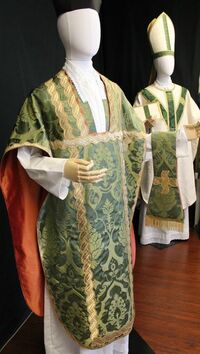about us...
Meditating on the 10th Station of the Cross, we are vestment makers seeking to glorify God
by restoring the sense of the sacred through exquisite vestiture for the Holy Sacrifice of the Mass.
 "Tenth Station of the Cross" oil on canvas Susan Jasper, Jasper Artisan Guild
"Tenth Station of the Cross" oil on canvas Susan Jasper, Jasper Artisan Guild
Making Catholic vestments was never something we planned to do. It grew from a young priest's need of repairs to old vestments used at our parish. But in order to patch them up and make the missing pieces match their age, it was a painstaking process of finding old tarnished scraps. One day, I was suddenly struck with a deep sadness. I thought I was doing something good, but the fact was, for all the goodness that God has shown me, I was busy offering Him stained dirty scraps for worship on the altar. Truly, some of the pieces were so decayed and their linings so moldy, how did anyone dare to sell them -- or priest to wear them? Just because something is old, doesn't make it worthy.
However, it wasn’t until attending my first priestly ordination that I fully recognized the heartbreaking gift that this labor is. Kneeling in the seminary chapel, I gazed up at one of the beautiful antique stations of the cross just above me. It was none other than the "Tenth Station" where Jesus is stripped naked of his garments moments before being nailed to the cross. But this lovely piece was made in France -- so that the word “garments” was “vêtement”! And then I understood.
For us, our King was stripped of his glory and dignity, made ugly and unrecognizable, mocked and shamed. In the Mass and through the sacraments, priests act in the person of Christ, offering worship and reparation for sin -- in “persona Christi”. As such, it is fitting that everything used for God's work be the very best that human hands can craft. So that, in a small way, we can comfort and clothe Christ by offering Him back some amount of the beauty and dignity He is due in all love and justice.
This is the cause for the joy we find in our labor and the reason for our name: Altarworthy.
However, it wasn’t until attending my first priestly ordination that I fully recognized the heartbreaking gift that this labor is. Kneeling in the seminary chapel, I gazed up at one of the beautiful antique stations of the cross just above me. It was none other than the "Tenth Station" where Jesus is stripped naked of his garments moments before being nailed to the cross. But this lovely piece was made in France -- so that the word “garments” was “vêtement”! And then I understood.
For us, our King was stripped of his glory and dignity, made ugly and unrecognizable, mocked and shamed. In the Mass and through the sacraments, priests act in the person of Christ, offering worship and reparation for sin -- in “persona Christi”. As such, it is fitting that everything used for God's work be the very best that human hands can craft. So that, in a small way, we can comfort and clothe Christ by offering Him back some amount of the beauty and dignity He is due in all love and justice.
This is the cause for the joy we find in our labor and the reason for our name: Altarworthy.
vestments are sacramentals

The priestly vestments worn in the Catholic Church are necessary for the celebration of Holy Mass and are in fact "blessed sacramentals". Before their first use on the altar, vestments undergo a sacramental blessing by a priest -- or a bishop may perform this honor on the ordination day of a new priest. It is very beautiful and highly symbolic.
Each piece in a set of vestments has a timeless and critical role to play in the Mass. And as such, the priest is obliged to offer prayers with the vesting of each piece in the sacristy, hidden from view but all important as he recollects himself for the dangerous work he is about to undertake: celebration of the Mass and handling of the Eucharist.
If sold for money, a vestment loses this sacramental status and must be re-blessed before being put back into service. Additionally, a vestment that can no longer perform its function due to age or wear, must be burned or buried.
Each piece in a set of vestments has a timeless and critical role to play in the Mass. And as such, the priest is obliged to offer prayers with the vesting of each piece in the sacristy, hidden from view but all important as he recollects himself for the dangerous work he is about to undertake: celebration of the Mass and handling of the Eucharist.
If sold for money, a vestment loses this sacramental status and must be re-blessed before being put back into service. Additionally, a vestment that can no longer perform its function due to age or wear, must be burned or buried.
northwest catholic magazine
Printed issue of Northwest Catholic: "Clothing Christ" by Jean Parietti (Jan-Feb 2017) Archdiocese of Seattle
